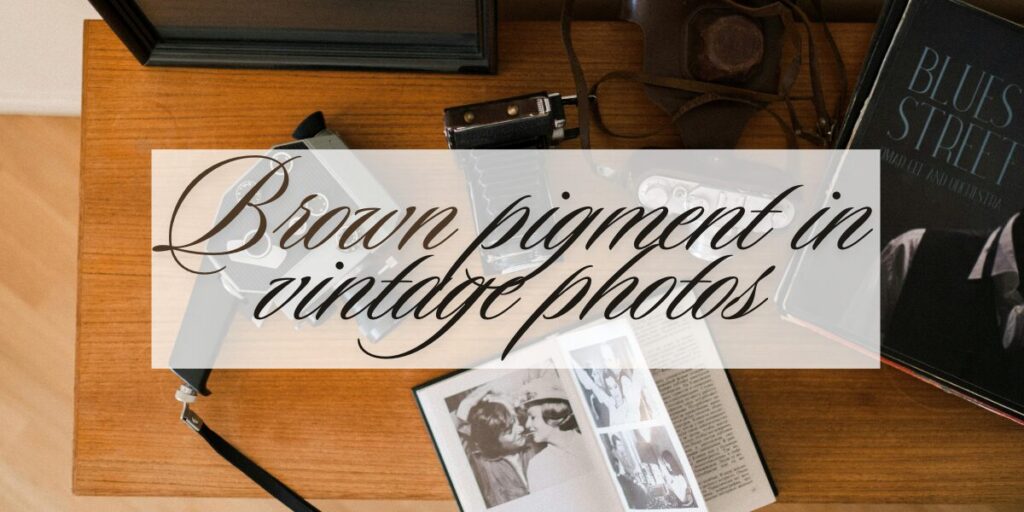Brown Pigment in Vintage Photos: Unveiling the Culprit

Imagine this: you’ve unearthed a dusty box filled with family treasures, eager to delve into the past. As you gently unfold a faded photograph, a wave of nostalgia washes over you. The image captures a joyous moment – a birthday party, a graduation, or a cherished family vacation. But a shadow of disappointment quickly falls as you notice the brown pigment in vintage photos.
This experience is all too common. Countless vintage photographs suffer from this curious browning, transforming cherished memories into a muted echo of their former glory. But what causes this phenomenon? Why do these once-vibrant images succumb to the relentless march of time?
The answer lies in the very science behind photography itself. Traditional photographic processes rely on the light sensitivity of silver halide crystals embedded within the film. When exposed to light, these crystals undergo a chemical reaction, capturing the scene as a latent image. Development then transforms this invisible image into a visible photograph. However, this delicate balance can be upset, leading to the dreaded brown discoloration.
Contents
Unveiling the Culprit: A Multifaceted Mystery
The culprit behind the brown discoloration in vintage photos isn’t a single villain, but rather a confluence of chemical and environmental factors. Let’s delve deeper into the science behind this phenomenon.
A. The Silver Screen: A Fading Light Show
Traditional photography relies on the remarkable property of silver halide crystals. These microscopic light-sensitive particles are suspended within the film emulsion. When light strikes the film during exposure, it triggers a chemical reaction within these crystals, creating a latent image – an invisible record of the scene. The development process then transforms these altered crystals into metallic silver, making the image visible.
B. The Villain Unmasked: Chemical Breakdown
Unfortunately, this delicate process is susceptible to disruption. Improper storage or processing can lead to the breakdown of silver halide crystals, resulting in the dreaded brown discoloration. Here are the key environmental culprits:
- Light: Excessive exposure to light, even after development, can further degrade the silver halide crystals, accelerating the browning process.
- Heat: Elevated temperatures can exacerbate the breakdown of silver halide crystals, acting as a catalyst for the chemical reactions that lead to browning.
- Humidity: High humidity levels create a breeding ground for chemical reactions within the film. Moisture can also contribute to the growth of mold or fungus, further accelerating deterioration.
Adding to the complexity, the development process itself can sometimes play a role. The thiosulfate fixer, a chemical bath used in development, is crucial for removing unexposed silver salts from the film. However, incomplete removal of these salts can leave behind traces that eventually contribute to browning over time.
C. Beyond Silver: Unveiling Other Brown Culprits
While silver halide breakdown is the primary culprit, other factors can contribute to brown discoloration in vintage photographs:
- Cellulose Nitrate Negatives: Early photographic processes used negatives made from cellulose nitrate, a highly unstable material. Over time, cellulose nitrate degrades, releasing acidic byproducts that can cause the paper base to turn brown and brittle.
- Mold and Fungus: In damp storage conditions, mold or fungus growth can manifest as brown discoloration on the photograph’s surface. These organisms feed on the organic materials within the film or paper base, causing further damage.
By understanding these multifaceted causes of brown discoloration, we can take proactive measures to preserve our precious photographic memories.
Restoring the Past: Preserving Our Fading Memories
The discovery of brown discoloration in vintage photos can be disheartening. However, all is not lost! By taking proactive steps, we can prevent further damage and even explore avenues for restoration.
A. An Ounce of Prevention: Proper Storage is Paramount
The good news is that the fight against brownification largely hinges on proper storage. Here are some key strategies to safeguard your precious photographs:
- Location, Location, Location: Choose a cool, dry, and dark environment. Avoid storing photos in attics, basements, or areas with fluctuating temperatures and humidity.
- Embrace the Dark: Minimize light exposure. Store photos in archival-quality boxes or enclosures made from acid-free materials like lignin-free cardboard.
- Separate and Conquer: Don’t store photos in direct contact with each other. Utilize protective sleeves made from Mylar or polypropylene to prevent sticking and scratches.
By following these simple storage guidelines, you can significantly slow the deterioration process and extend the lifespan of your vintage photographs.
B. When Prevention Falls Short: Seeking Professional Help
Unfortunately, not all photos can be saved through proper storage alone. For severely damaged or particularly valuable photographs, seeking professional help from a qualified photo conservator is crucial. Conservators possess the expertise and specialized equipment to address a wider range of issues, including:
- Digital Restoration: Advanced software can be used to remove blemishes, correct color imbalances, and even enhance faded details in some cases.
- Chemical Baths: Professionals can utilize specialized chemical baths to arrest the breakdown of silver halide crystals and potentially reverse some browning.
Remember, consulting a professional can significantly improve the chances of successful restoration, especially for irreplaceable photographs.
C. The Allure of Imperfection: Embracing the Vintage Look
While brown discoloration may not be ideal, it’s important to acknowledge the aesthetic value some collectors find in vintage photographs with a faded, “aged” look. The presence of brown tones can even contribute to the historical context and authenticity of the image. Ultimately, the decision to restore or embrace the imperfections rests with the owner.
The key takeaway is to understand the causes of brown discoloration and take appropriate action to preserve your cherished memories. Whether you choose to prevent further damage, enlist professional help, or simply appreciate the vintage aesthetic, the power to safeguard your photographic legacy lies in your hands.
FAQ’s: Brown pigment in vintage photos
Q- What are the brown pigments in vintage photos?
Brown splotches on vintage photos? Blame the breakdown of tiny light-sensitive crystals (silver halide) in the film. Light, heat, and humidity accelerate this process. Improper processing can also leave behind lingering chemicals that turn brown over time. In rare cases, the paper base itself or mold growth can contribute to the browning.
Q- What is the brown pigment in old photos?
The brown splotches on old photos are the culprit of tiny light-sensitive crystals (silver halide) breaking down. This breakdown is caused by light, heat, humidity, or improper processing. In rare cases, the paper itself or mold growth can also turn brown.
Q- What is the brown color in old photos?
The brown color in old photos is the result of a chemical breakdown, mainly affecting the light-sensitive silver halide crystals used to capture the image. Here’s a quick explanation:
Silver Halide Breakdown: Over time, these crystals can degrade due to factors like light, heat, or humidity. This breakdown creates byproducts that appear as brown discoloration on the photo.
Q- What is the word for brown pigment in vintage photos?
There isn’t a single word for the brown color in old photos. It’s caused by various materials breaking down, not one pigment, and the brown itself can vary in shade. “Browning” is the most general term.
Conclusion: Brown Pigment in Vintage Photos
The brown discoloration that plagues vintage photographs is a consequence of the delicate interplay between science and environment. We’ve explored the breakdown of silver halide crystals as the primary culprit, alongside the accelerating effects of light, heat, and humidity. Improper storage or processing can exacerbate these issues, leading to the browning we so often encounter.
The good news is that we’re not powerless against this foe. By implementing proper storage techniques like cool, dark environments and archival-quality enclosures, we can significantly slow the deterioration process. For severely damaged or valuable photographs, seeking professional help from a qualified conservator opens doors to advanced restoration options like digital touch-up or specialized chemical baths.
However, it’s also important to acknowledge the artistic merit some find in the faded beauty of vintage photographs. Brown tones can add a layer of historical context and authenticity, depending on the image and personal preference.
The ultimate takeaway is this: understanding the causes of brown discoloration empowers you to make informed decisions about preserving your precious memories. Whether you choose prevention, professional restoration, or appreciation of the vintage aesthetics, you’re now equipped to safeguard your photographic legacy.
Looking ahead, the future of photo preservation is bright. Advancements in digital technology offer user-friendly tools for enthusiasts to scan and archive their photos. Additionally, ongoing research in photo conservation materials and techniques promises even more effective solutions for protecting our irreplaceable visual histories.
So, the next time you discover a vintage photograph, don’t despair if you encounter a touch of brown. With knowledge and proactive measures, you can ensure these cherished memories continue to tell their stories for generations to come.








